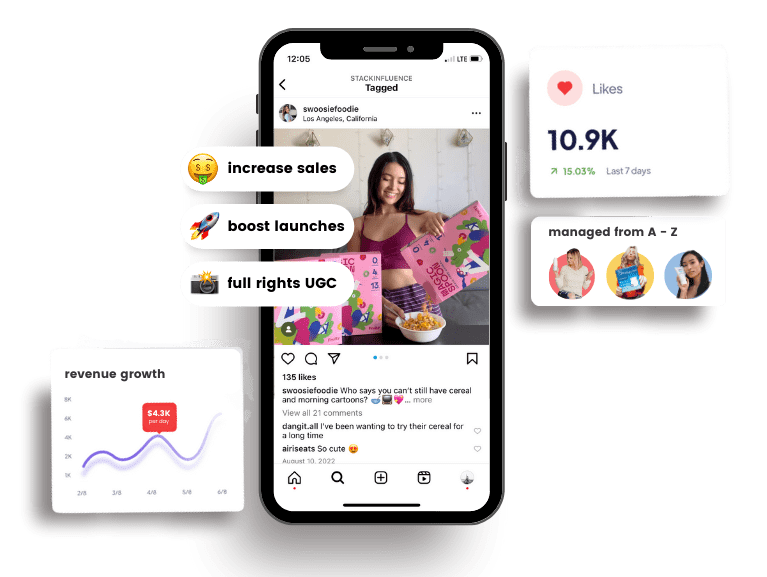7 Strategies for Effective Community Building
8th
October, 2025
Influencer Marketing
Amazon Marketplace
Artificial Intelligence
TikTok Tips
Building a loyal brand community is more important than ever in today’s marketplace. With consumers increasingly tuning out traditional ads and trusting peer recommendations, brands must foster genuine relationships to thrive. A strong community not only gives you valuable feedback on products but also turns customers into enthusiastic advocates for your brand. Below, we’ll explore seven effective strategies for community building – tailored for e-commerce brands, Amazon sellers, and any company looking to cultivate an engaged audience.
1. Collaborate with Micro-Influencers for Authentic Reach

One of the fastest ways to build a community around your brand is by partnering with influencers, especially micro-influencers and niche content creators. These are individuals with smaller but highly engaged followings who can authentically champion your products. Collaborating with micro-influencers infuses credibility into your marketing – their recommendations feel like advice from a friend rather than an ad. In fact, Stack Influence reports that 82% of consumers are highly likely to follow a micro-influencer’s recommendation, and nearly 90% say authenticity is important when deciding which brands to support. It’s no surprise that 86% of marketers plan to partner with influencers in 2025, as this strategy has become mainstream for brand growth.
Micro-influencers offer unusually high engagement and community impact for the cost. Their posts generate engagement rates as high as 5–20%, far above the ~1–3% typical of big influencers. That means a more loyal, interactive audience seeing your brand. Additionally, micro-influencer campaigns can deliver an ROI of around 20:1 (each $1 yielding $20 in revenue), compared to roughly 6:1 for macro-influencers. In other words, brands get more bang for their buck collaborating with many niche creators than putting their whole budget into one celebrity. Given these advantages, it’s no wonder e-commerce companies and Amazon sellers are ramping up micro-influencer collaborations to build community and trust. To start, identify influencers who genuinely love your niche – for example, a tech gadget brand might partner with a YouTube reviewer known for honest gadget reviews, or an Amazon Marketplace seller in beauty might team up with a skincare micro-influencer. By co-creating content and engaging their audiences, you’ll tap into existing communities and bring those like-minded people into your brand’s circle.

Unlock the Power of Micro Influencers and Elevate your Brand Today!

2. Meet Your Audience Where They Are on Social Media
Your potential community members are already out there connecting in social media groups and online communities – so go join the conversation. Rather than expecting customers to come to you, leverage the platforms and forums where your audience hangs out. This could mean participating in a popular subreddit related to your industry, engaging in Facebook Groups, or simply being highly responsive on your brand’s Instagram and TikTok accounts. People love to bond over shared interests and experiences: fitness enthusiasts swap workout tips on Instagram, Amazon sellers discuss tactics in online forums, and hobbyists gather in niche Facebook groups. By being active where your customers naturally congregate, you make your brand a part of those organic “tribes.”
Importantly, don’t use social channels just for one-way promotion – use them to listen and engage. For example, respond to comments on your posts, jump into discussions (when appropriate) with helpful insights, and show personality in your replies. If your brand is in e-commerce, consider creating a community hashtag or a user club. Outdoor gear retailers, for instance, might encourage fans to share hiking photos with a branded hashtag and then repost the best ones. Meeting your audience on their turf shows that your brand is approachable and tuned in to the community. Over time, these interactions build familiarity and trust. When people see your brand actively contributing value (not just selling), they’ll be more inclined to join your follower base and eventually become advocates.
3. Encourage User-Generated Content and Co-Creation
User-generated content (UGC) – posts, photos, videos, and stories created by your customers – is like rocket fuel for community building. When customers create content featuring your brand, they become co-creators of your brand story. This not only provides you with a wealth of authentic content to share, but it also makes those customers feel more deeply connected to your brand. UGC is powerful social proof: seeing real people use and love a product builds trust among other potential buyers. In fact, user-generated content from genuine fans can be more persuasive than any ad campaign. It feels more genuine than polished ads, which helps build credibility with audiences.
To spur UGC, invite your community to participate in creative ways:
-
- Run hashtag challenges or contests. For example, an apparel brand could launch a #StyleWithMyBrand challenge encouraging users to post outfit photos using a branded hashtag, with a chance to be featured or win store credit.
- Repost and celebrate UGC. Share the best customer photos or testimonials on your official social media (always giving credit). Shining a spotlight on your fans’ content shows you value them and inspires others to join in.
- Collaborate with creator customers. Identify enthusiastic customers who have creative skills (photography, blogging, etc.) and invite them to contribute content or take over your social media for a day. This level of involvement turns fans into brand partners.
- Run hashtag challenges or contests. For example, an apparel brand could launch a #StyleWithMyBrand challenge encouraging users to post outfit photos using a branded hashtag, with a chance to be featured or win store credit.
Co-creating content with your community makes marketing feel more like a conversation. Brands like GoPro and Starbucks have mastered this – featuring customer photos or stories as central to their marketing. Even smaller e-commerce brands can do it: for instance, if you sell handmade candles online, encourage buyers to share photos of the cozy ambiance your candles create at home. Not only do you get free authentic content, you also make those contributors proud members of your community. Tip: Keep an eye on what content your users are making spontaneously. That feedback can guide your marketing (and even product development, as we’ll cover next).
4. Listen to and Engage with Customer Reviews
In community building, the conversation is two-way. One place many brands falter is by ignoring customer reviews. Don’t let that happen – pay close attention to product reviews and actively engage with them. Reviews, whether on your website, on Amazon, or on social media, are gold for understanding your community’s sentiment. Responding to reviews (both positive and negative) shows that there are real people behind the brand who care. In fact, 52% of consumers expect to hear back from brands within a week of leaving an online review, yet many brands still neglect to reply. Simply acknowledging a customer’s review can turn a passive customer into an active community member because they feel heard.
Positive reviews are opportunities to reinforce advocacy. A quick “Thank you, we’re so glad you love the product!” on a 5-star review goes a long way. Better yet, share or highlight great reviews in your community – for example, feature a “review of the week” in your newsletter or social posts. This not only flatters the reviewer, drawing them closer to your brand, but also provides social proof to others. Remember, 88% of consumers trust online reviews as much as personal recommendations, and 72% will take action after reading a positive review.
Negative reviews are even more critical to engage. Rather than deleting or ignoring criticism, address it head-on and swiftly. Apologize for any issues and offer to make it right. This responsiveness can actually benefit your community reputation: potential customers see that you care and existing customers get their problems resolved. 83% of customers say they feel more loyal to brands that respond and resolve their complaints so tackling a bad review constructively can turn a dissatisfied customer into a loyal advocate. Every review is a chance to have a dialogue. By actively participating in review conversations, you show the whole community that their opinions matter – which encourages more people to join the discussion around your brand.
5. Incorporate Customer Feedback into Your Products
Your community isn’t just there to cheer you on – they’re also an invaluable source of ideas and critiques to help you improve. Incorporating customer feedback into your products and services closes the loop of community building. When people see their suggestions implemented, it creates a deep sense of ownership and loyalty. So, move beyond just collecting feedback and show customers you’re listening by acting on it. For example, if multiple customers request a new feature or flavor, or report an issue, consider those insights in your next product iteration. Even e-commerce giants use this strategy: Amazon famously uses customer feedback data to inform product tweaks and new offerings. As a smaller brand or Amazon seller, you can be even more agile – perhaps launching a limited-edition product based on a fan suggestion or adjusting a policy due to community input.
A practical approach is to set up feedback channels that make customers feel heard. This could be a dedicated feedback form, a beta tester group drawn from your community, or live Q&A sessions where customers can directly share ideas. Invite your community into the product development process. For instance, a software-as-a-service company might have a public roadmap where users can vote on upcoming features. Or a cosmetics brand could send samples of a new formula to loyal community members for early feedback before a full rollout. By co-creating solutions with your audience, you demonstrate respect for their opinions. This not only leads to better products, but customers will often reward you with long-term loyalty (since they see their fingerprints on what you offer!). In short, build with your community, not just for them. When customers feel like partners in your brand’s journey, your community becomes much stronger and more invested.
6. Host Events to Bring Your Community Together

Nothing solidifies a community quite like real-time interactions. Hosting events – whether in-person or virtual – is a powerful community-building strategy that allows your brand and customers to connect on a more personal level. In the age of online everything, meeting your customers “in real life” (or live via video) can humanize your brand immensely. This could range from small local meetups and workshops to larger webinars or live-streamed conferences. The format isn’t as important as the experience of coming together. In-person activations are especially impactful: there’s just something memorable about shaking someone’s hand, sharing a laugh face-to-face, or letting customers touch and feel your product in an event setting. It forges friendships among community members and builds emotional ties to your brand. It’s also great for business – nearly 47% of event marketers say in-person events deliver the highest ROI of all marketing channels, and 83% include live events in their strategy.
Think about what kind of event makes sense for your brand and community.
Some ideas include:
-
-
- Workshops or Classes: Teach a skill related to your product. If you sell coffee equipment, host a virtual barista class or an in-store coffee tasting night.
- Meetups and Networking: Facilitate a casual meetup for customers in a city or a Zoom hangout for your online followers. This helps community members bond with each other.
- Webinars or AMA (Ask Me Anything) Sessions: Especially for digital products or widespread communities, live online sessions where you share knowledge or answer questions can be engaging.
- Pop-up Shops or Brand Experiences: If feasible, create a pop-up event or partner with existing events (e.g., a booth at a local market) to interact with your fans and attract new ones.
- Workshops or Classes: Teach a skill related to your product. If you sell coffee equipment, host a virtual barista class or an in-store coffee tasting night.
-
When planning events, offer value and fun, not just a sales pitch. The goal is to reward your community with an experience. For example, a fitness apparel brand might host a free group workout in the park for customers, or an online craft marketplace might run a virtual craft-along session. These gatherings give your fans a story to tell and a memory associated with your brand. Post-event, you’ll likely see a surge in community energy – attendees might post about it (more UGC!), tell friends, or just feel a closer connection to your company. Over time, periodic events can become cornerstone moments for your community, sustaining enthusiasm year after year.
7. Build an Affiliate or Ambassador Program to Reward Advocates
Your happiest customers are already spreading the word about you – why not formalize that relationship and reward them for it? Turning engaged community members into affiliates or brand ambassadors can supercharge your community building. An affiliate program typically means offering community members a commission or perk for any sales they drive via special links or codes. This gives your advocates a financial incentive to keep promoting your brand to their friends, followers, or network. It’s a win-win: they earn rewards, and you gain new customers through trusted recommendations. It’s also extremely cost-effective – no wonder 81% of brands use some form of affiliate marketing as part of their strateg.
Alternatively or additionally, you can establish a brand ambassador program. Ambassadors are often long-term partners who may not be compensated per sale like affiliates, but instead get perks such as free products, exclusive access, or social recognition in exchange for promoting the brand. These could be influencers, loyal customers, or even employees who love your mission. The key is that they become the voices consumers trust – relatable people talking about your brand in an authentic way, rather than the brand talking about itself. For example, many e-commerce apparel brands have ambassador teams that regularly post wearing their clothing, and in return get early access to new lines and feature spots on the brand’s Instagram. Amazon sellers might offer their best reviewers a chance to join an insider club that gets early samples or discount codes to share.
When setting up an affiliate/ambassador program, be sure to give clear guidelines and support. Provide your advocates with shareable content, tracking tools, and plenty of appreciation. Celebrate their successes publicly (like “Affiliate of the Month” shout-outs). By investing in your advocates, you make them feel like an integral part of the brand’s success – which they are! As they spread the word, your community grows with new like-minded customers coming in through a trusted introduction. Over time, this network of affiliates and ambassadors becomes a self-propelling engine of community growth, loyalty, and user-generated content. It takes your most passionate community members and elevates them into true partners.

Unlock the Power of Micro Influencers and Elevate your Brand Today!

Conclusion to 7 Strategies for Effective Community Building
In conclusion, building a vibrant community is about nurturing genuine relationships with and among your customers. From influencer collaborations and social media engagement to UGC, feedback loops, events, and affiliate programs, the common thread is authenticity and two-way value. You’re inviting people into something bigger than a transaction – a sense of belonging. By implementing these strategies, micro-influencers, content creators, e-commerce shoppers, Amazon sellers, and everyday users will feel more connected to your brand and to each other. The result is a community that not only boosts your brand’s growth and trust, but also becomes a lasting competitive advantage. Start with the strategy that resonates most with your audience, and build from there. With consistency and care, you’ll turn customers into loyal fans and casual buyers into a thriving, engaged community.

By William Gasner
CMO at Stack Influence
William Gasner is the CMO of Stack Influence, he's a 6X founder, a 7-Figure eCommerce seller, and has been featured in leading publications like Forbes, Business Insider, and Wired for his thoughts on the influencer marketing and eCommerce industries.
Want new articles before they get published? Subscribe to our Awesome Newsletter.
stack up your influence
turning creativity into currency
our headquarters
111 NE 1st St, Miami, FL 33132
our contact info
[email protected]
stack up your influence
turning creativity into currency
our headquarters
111 NE 1st St, 8th Floor
Miami, FL 33132


